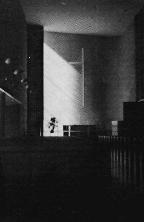Articles/Essays – Volume 03, No. 1
Mormon Architecture Today: The Temple as a Symbol
And send ye swift messengers, yea, chosen messengers, and say unto them: Come ye, with all your gold, and your silver) and your precious stones, and with all your antiquities; and with all who have knowledge of antiquities, that will come, may come, and bring the box-tree, and the fir-tree, and the pine-tree, together with all the precious trees of the earth;
Doctrine & Covenants 124:26-27.
And with iron, with copper, and with brass, and with zinc, and with all your precious things of the earth; and build a house to my name, for the Most High to dwell therein.
For thousands of years cultured civilizations have glorified their God with buildings of extraordinary beauty and craftsmanship. The modern world, in the midst of an almost frightening technical sophistication, still marvels at the magnificence of the creations of the devoted men of the earlier and less technically capable generations. Pondering a great temple of the past, be it Greek, Islamic or Gothic, the modern viewer is haunted by the question, “Why did they do this; what drove them to produce this astounding structure?”
We are told that these great symbols were produced out of fear, and we are also told that they were produced out of love. Some would have us believe that they were built by slaves, and others insist that they were built by religious fanatics. The most significant point, however, is that we find it easy to agree that the great temples of the past were the efforts of gifted men who provided special environments of rare beauty for their religious activities, and in the process left a legacy for the inspiration of future generations.
It is generally assumed that religious structures have as their primary purpose the glorification of God and the edification of man. In terms of simple dimensional requirements, religious activities can be satisfactorily accommodated in houses, barns or gymnasiums-the number of participants becomes the sole determining factor. However, the very nature of “worship” has always implied a suitability of environment which negates mere dimensional adequacy as the primary factor in design. When environment created for religious purposes fails to provoke the desired emotional response from the participant, the structure has failed to fulfill its principal purpose.
The truth of the Mormon faith is not the Mormon Temple. Neither is the Mormon Temple a symbol of the truth of the Mormon faith. The Mormon Temple is, however, a symbol of the Mormons’ belief in the truth of their faith. Standing on Temple Square, the non-Mormon may be inclined to ask why the Mormons believed what they did, but the non-Mormon knows, simply by viewing the Temple, that the builders of the Temple did believe. The symbol of their belief, the Temple, is firm, it is powerful, it is not cowering or noncommittal. It is easily discerned to be the work of men who were sure of their purpose. Judged strictly as a work of art, this building is ill-proportioned, and from the exterior falsely represents the spatial divisions on the interior. The carving, as Rudyard Kipling stated, is “pitiful scratching in stone.” However, when judged as a symbol of a group’s unwavering belief in things spiritual, it is a successful statement.
What, then, can be said of the proposed design for the new temples soon to be built in Ogden and Provo? A photograph of one of them taken from the local newspaper, when circulated to young architects with the caption removed, was identified as almost every type of building other than a religious structure. Only one individual properly identified the building, and he sarcastically suggested it could only be a Mormon structure of some kind. This is a sad commentary on contemporary Mormon architecture. As a symbol, the new temples will tell a story quite different from that of the edifice on Temple Square.
The very fact that one design was created for two separate temples suggests mass production is playing a role in contemporary Mormonism. The mercantilistic quality of the design suggests that modern Mormonism is more concerned with commercialism than with spiritual matters. The “newness” and “prettiness” of the design suggests a denial of the resolve of the early Church.
Mormonism has a proud tradition and a rich heritage. Where is this expressed in the new design? Mormonism is supposedly an expanding and viable faith. The new design suggests the swan-song of a diminishing tribe. A wealthy church, in one of the world’s most affluent societies, owes its faithful more than what they have been offered in these designs of the Church architect. The early pioneers would not have been so callous in their approach to housing the activities of their faith.
Fifty or one hundred years from now future generations may sit and ponder one of these new temples and ask the same questions we ask today of the temples of the past: “Why did they do this; what drove them to produce this astounding structure?” The church that produced the structure will have to be the church that answers the questions. The new design suggests that that church may not be around to provide the answer.


 Back to full Issue
Back to full Issue

